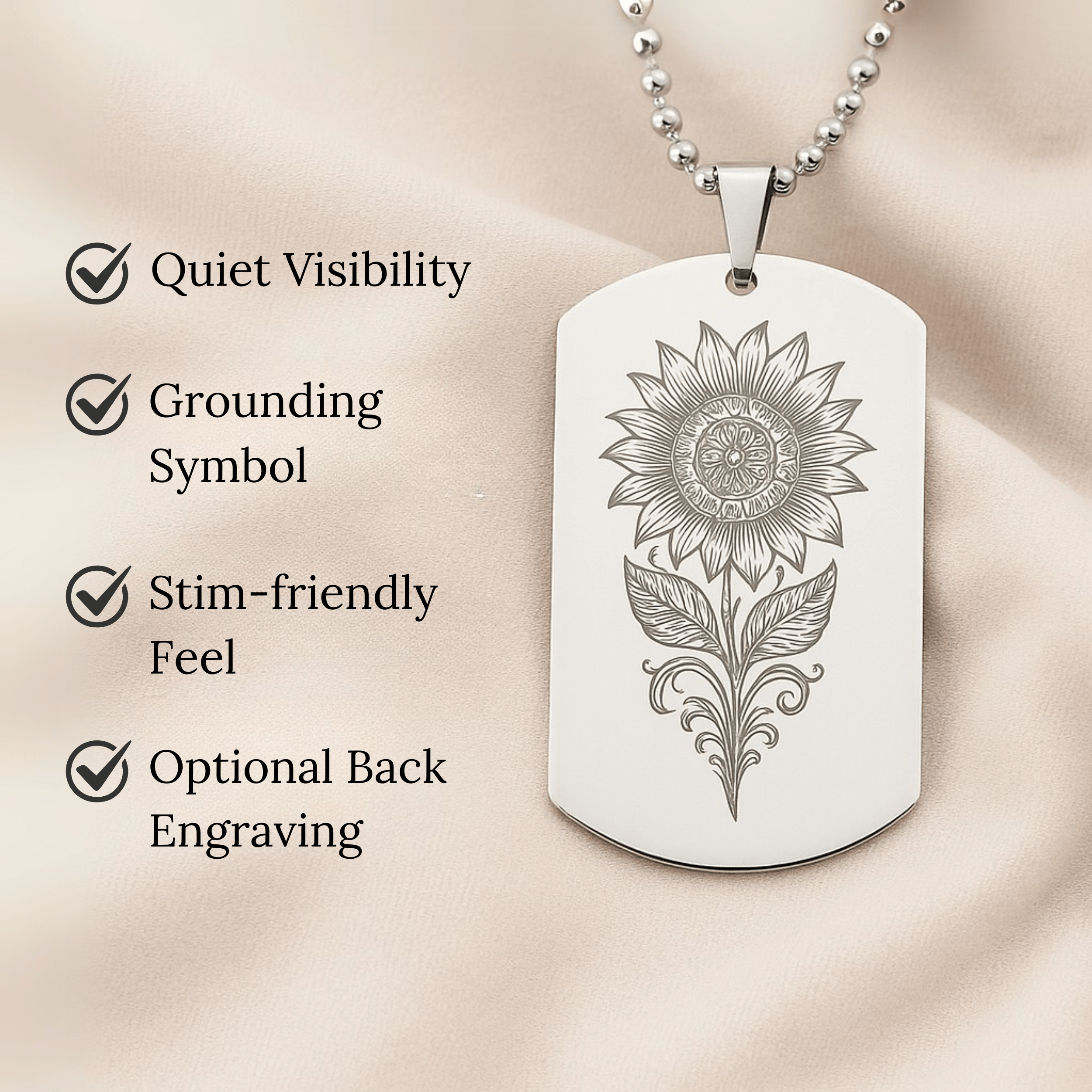Interoception and Autism: Reconnecting With Your Body’s Inner World
Interoception is your body’s way of speaking to you - through hunger, heartbeat, or fatigue. For many autistic adults, those signals can be muted or confusing. Understanding your interoceptive sense isn’t about “fixing” it, but learning to listen with compassion.

Written by the HeyASD Editorial Team
Have you ever felt disconnected from your body’s signals — like hunger, fatigue, or emotion — and wondered why? That inner sense is called interoception, the awareness of what’s happening inside your body. For many autistic adults, interoception can work differently. It’s not a flaw or deficit — it’s simply another way of being.
“It’s not that I don’t feel things. It’s that my body speaks in whispers, and sometimes I can’t quite catch the words.”
This guide explores how interoception relates to autism, how it affects daily life — from hunger and toileting to emotions — and how to nurture a gentler, more trusting relationship with your body.
What Is Interoception?
Interoception is the perception of your body's internal states. Think of it as a constant conversation between your body and your brain. This sense processes internal signals to help you understand and respond to your body's needs.
These bodily sensations are fundamental to your physical and emotional health. Developing your interoceptive awareness can help you feel more connected to yourself. Let's explore the basics of this internal sense, see some daily examples, and understand why it’s so important for comfort and self-knowledge.
The Basics of Interoception: Listening to Your Body’s Inner Signals
Interoception is often described as the "body-to-brain axis." It’s a vital sense that allows your brain to monitor and regulate many of your body’s essential processes, from digestion to heart rate. It works through a network of receptors inside your organs that send information up to your brain.
This sensory processing of bodily signals is what helps you maintain balance, or homeostasis. When you notice you're thirsty and get a drink, that is your interoceptive system at work. This awareness is the foundation for responding to your body’s needs in real time.
Improving your interoceptive awareness isn’t about being perfect; it's about learning to listen more closely to what your body is telling you. It’s a gentle process of building a stronger, more compassionate relationship with your inner world and physical sensations.
Day-to-Day Examples of Interoceptive Awareness
You experience interoception constantly, even if you don’t notice it. It’s the sense that helps you recognize a wide range of internal body signals that guide your actions and feelings throughout the day. Your body awareness is built on these subtle cues.
What might these interoceptive signals feel like? They are the physical feelings that tell you about the state of your body. Some common examples include:
-
The feeling of your heart beating faster or slower.
-
The sensation of your stomach feeling full after a meal.
-
The subtle cue of thirst telling you it's time to hydrate.
-
The feeling of muscle tension when you're stressed.
Recognizing these internal states is the first step toward addressing your needs. If these signals are faint or confusing, it can be challenging to know what your body requires from moment to moment.
Why Interoception Matters: Comfort, Health, and Self-Knowledge
Your ability to sense your internal world is directly linked to your physical health and emotional wellbeing. When you can accurately interpret interoceptive information, you can better regulate vital functions like eating, drinking, and resting, which are cornerstones of good health.
This sense is also deeply connected to emotional regulation. The physical feelings in your body are often clues to your emotional state. By understanding these cues, you can better identify and manage your emotions, which can significantly benefit mental wellbeing by reducing anxiety and confusion.
Ultimately, interoception is a pathway to greater self-knowledge. Tuning into your body helps you understand your needs, respect your limits, and build a more compassionate connection with yourself. It empowers you to take charge of your comfort and lead a life that honors your unique wiring.
How Does Interoception Work in the Body?
Interoception is a complex process managed by your nervous system. It begins with sensory receptors located throughout your body’s organs, which constantly monitor your body's internal environment. These receptors pick up on internal signals and send them on a journey to your brain for interpretation.
This communication pathway is crucial for your survival and wellbeing. Understanding how these signals travel and how the brain makes sense of them can demystify why your internal experiences might feel different. Let's look at the brain-body connection, the key cues it tracks, and the unique pathways in autism.
The Brain-Body Connection: From Signal to Awareness
Once an internal signal is detected by a receptor in your body, it travels through your central nervous system to your brain. This intricate network acts as a highway for information, ensuring that messages about your body’s state are delivered for processing.
A key brain region involved in this process is the insular cortex. Think of the insula as a hub that receives and integrates these signals, helping to translate them into conscious feelings. It’s where raw data from your body begins to take shape as a recognizable sensation, like hunger or a racing heart.
This entire brain-body loop is what creates your sense of what's happening inside you. Differences in how the central nervous system or the insular cortex process these internal signals can lead to a very different experience of interoception.
Key Internal Cues: Hunger, Thirst, Heartbeat, Fullness, Emotions
Your interoceptive system is responsible for tracking a variety of essential bodily sensations. These cues are your body’s way of communicating its needs and are directly tied to your emotional experience.
Being able to notice and interpret these signals is key to maintaining your wellbeing. Some of the most important internal cues include:
-
Hunger and Fullness: Signals from your gut that tell you when to eat and when to stop.
-
Thirst: Cues related to your body's hydration levels.
-
Heartbeat: The perception of your heart rate, which can change with exertion or emotion.
-
Breathing: Awareness of your respiratory rate and depth.
These physical feelings are often intertwined with your emotions. For example, anxiety might feel like a knot in your stomach or a rapid heartbeat. Learning to connect these bodily sensations to your emotional world is a powerful part of self-understanding.
Interoceptive Processing: Unique Pathways in Autism
Research suggests that interoceptive processing can be different for many on the autism spectrum. Studies exploring this connection have found that while some autistic people report heightened attention to internal cues, others find them to be muted or confusing. This shows that there isn't one single "autistic experience" of interoception.
These variations in sensory integration may mean that the brain interprets internal signals differently. Some studies have found that autistic people may be less accurate on certain objective tasks, like counting their own heartbeats, even if they feel confident in their ability.
These interoceptive differences are common, but they manifest in many ways. It highlights that the autistic nervous system has a unique way of processing the world, both inside and out. Understanding your specific profile is more important than comparing it to a "typical" one.
Interoception and Autism: What the Science Shows
Scientific interest in the link between interoception and autism spectrum disorder has grown significantly. Researchers are working to understand how differences in interoceptive abilities might relate to the daily experiences of autistic people. A recent systematic review compiled data from many studies to get a clearer picture.
This research aims to move beyond single studies to find more robust conclusions. It helps clarify what we know about interoceptive differences and what questions still need answers. Let's look at how common these differences are, what current research shows, and what brain studies are revealing.
Are Differences in Interoception Common in Autism?
Yes, interoceptive differences are a common part of the autistic experience, but the way they show up varies greatly. Research has provided inconsistent results, with some studies finding clear differences between autistic and neurotypical people, while others have failed to replicate those findings.
This inconsistency suggests that interoception isn't a simple, one-size-fits-all concept. How autistic people experience their internal world can depend on the specific task being measured, individual factors, and the unique wiring of their nervous system.
So, while it's accurate to say that interoceptive differences are common in the autistic community, it's also true that this experience is highly individual. These differences are not a deficit but a natural variation in sensory processing.
Research on Autism Interoception: Current Insights
To better understand the connection between interoception and autism, researchers have conducted a systematic review of existing studies found on platforms like Google Scholar. This approach combines results from multiple sources to identify reliable patterns in interoceptive processes.
One major review synthesized data from 15 different studies. It compared autistic and neurotypical groups on several measures of interoception, revealing a complex picture. The findings suggest that differences are present but are specific to certain tasks.
Here is a simple breakdown of the key findings from that meta-analysis:
|
Interoception Measure |
Finding in Autistic vs. Neurotypical Groups |
|---|---|
|
Heartbeat Counting Task (Accuracy) |
Autistic participants showed reduced performance on average. |
|
Heartbeat Discrimination Task (Accuracy) |
Groups performed at a practically equivalent level. |
|
Heartbeat Counting Confidence (Subjective) |
Autistic participants reported significantly higher confidence. |
|
Subjective Interoceptive Attention (Self-Report) |
No significant group differences were found on average. |
These results highlight a fascinating mismatch between objective performance and subjective feeling for some interoceptive tasks.
Brain Studies: Patterns of Interoception in Autism
To understand interoception on a deeper level, scientists are studying what happens in the brain. This research looks for the neural correlates of cardiac interoceptive focus—in other words, the brain activity associated with paying attention to your heart.
Much of this work has focused on the insular cortex, a key brain region for processing internal body signals. Studies are exploring whether activity or functional connectivity—how different brain regions communicate—in the insula and related networks differs in autistic people during interoceptive tasks.
While this field is still emerging, the goal is to understand the biological basis for the varied interoceptive experiences in the autistic community. This research helps validate that these differences are real and rooted in the unique structure and function of the autistic brain, not a lack of effort.
Recognizing Interoceptive Challenges in Autism
Recognizing interoceptive challenges is the first step toward finding supportive strategies. For many autistic people, the body signals that others take for granted can feel muted, overwhelming, or simply confusing. This can make it hard to respond to your body's needs.
These challenges are not a personal failing but a difference in sensory processing. Understanding how these differences can manifest can help you identify your own patterns and find ways to work with your body, not against it. Let's explore the spectrum of awareness, what happens when signals get mixed, and some common scenarios.
Over- vs Under-Awareness: A Spectrum of Experience
Interoceptive awareness exists on a spectrum, and autistic individuals can fall anywhere on it. Some people may experience over-awareness, where internal sensations are so intense they become distracting or even painful. A slightly elevated heart rate might feel like a medical emergency, and the feeling of digestion can be a source of constant discomfort.
On the other end is under-awareness, where bodily needs go unnoticed. You might not realize you are hungry until you feel faint or not recognize you need the bathroom until it's an absolute emergency. These signals are not being ignored; they simply aren't reaching conscious awareness with enough intensity.
Many autistic people find their experience fluctuates between these two poles or is inconsistent across different sensations. The key is to compassionately observe your own patterns without judgment.
Unpredictable Signals: When Cues Are Missed or Mixed
For some autistic people, the challenge isn't just about signals being too strong or too weak—it's that they are unpredictable and confusing. You might feel a strong physical sensation but have no idea what it means. Is that flutter in your stomach anxiety, hunger, or excitement?
This ambiguity can make trusting your internal states very difficult. Research has shown a mismatch where autistic participants might feel very confident in their interoceptive abilities even when objective tests show lower accuracy. This suggests that the subjective feeling and the objective reality of sensory input don't always align.
This disconnect can have a significant impact on emotional processing. If you can't reliably link a physical sensation to an emotion, it becomes much harder to understand and regulate your feelings.
Common Scenarios and Signs to Notice
Differences in processing interoceptive signals can show up in many ways in daily life. Noticing these patterns in yourself or your loved ones can provide valuable insight. These experiences are common for both autistic children and adults.
What might these challenges look like? Here are a few common scenarios that can arise from difficulty interpreting bodily signals:
-
Forgetting to eat or drink for long periods because hunger or thirst cues are not perceived.
-
Not realizing you are in pain or injured until the symptoms become severe.
-
Having trouble knowing if you are hot or cold, leading to dressing inappropriately for the weather.
-
Difficulty identifying feelings like fatigue or sickness, often pushing through until you experience autistic burnout.
Recognizing these signs is a chance to implement supportive routines rather than focusing on "fixing" the perception of the signals.
Emotional Regulation and Interoception in Autism
There is a powerful link between interoception and emotional regulation. Your emotions are not just thoughts; they are felt experiences in your body. When interoceptive signals are hard to read, it can be incredibly challenging to understand what you are feeling.
This confusion can make emotion regulation more difficult, as you may not notice an emotion building until it feels overwhelming. Learning to tune into your body, even in small ways, can be a cornerstone of emotional wellbeing. Let's look at the connection to alexithymia, meltdowns, and strategies for navigating this confusion.
Feeling Emotions Without Words: Alexithymia Explained
Alexithymia is a trait, common among autistic people, characterized by difficulty identifying and describing one's own emotions. If you've ever felt a strong feeling but couldn't put a name to it, you may have experienced this.
This is deeply connected to interoception. Reduced interoceptive ability is thought to be a potential basis for alexithymia. If you struggle to notice the internal sensations associated with emotions—like a racing heart with fear or a warm feeling with joy—it becomes much harder to build your emotional awareness.
This isn't about not having feelings; it's about a disconnect between the feeling and the ability to recognize and label it. This link between interoception and alexithymia shows how fundamental body awareness is to your sense of self.
The Link Between Interoception and Emotional Meltdowns
Emotional meltdowns can be a response to feeling completely overwhelmed. A key contributor to this overwhelm is often a buildup of unprocessed internal signals. When interoceptive awareness is low, it's easy to miss the early warning signs of distress, hunger, fatigue, or sensory overload.
Imagine your body sending quiet signals that it's reaching a limit. If you don't perceive these signals, you might continue in a stressful situation until your system is pushed past its breaking point. The resulting meltdown is not a behavioral choice but a physiological and emotional reaction to that overload.
This is true for both autistic children and adults. The emotional experience becomes unmanageable because the underlying physical and sensory needs were not met, often because they were not felt in time. Improving interoceptive awareness can help you recognize these cues earlier, allowing you to self-advocate and regulate before reaching a crisis point.
Strategies for Navigating Emotional Confusion
If you find it hard to understand your emotions, know that there are gentle ways to build that connection. The goal isn't perfection but curiosity. Interoceptive training involves practices designed to help you notice your internal world without judgment.
One initial study has shown that this kind of training can even help reduce anxiety in autistic adults. It works by strengthening the pathways between your body and brain, helping you become more fluent in your body's unique language.
Here are a few strategies to support your emotion regulation journey:
-
Curiosity Check-Ins: Pause and ask, "What am I feeling in my body right now?" Notice any sensation without needing to label it.
-
Body Scans: Gently guide your attention through different parts of your body, simply noticing what’s there.
-
Connecting Sensation to Emotion: When you do identify an emotion, ask where you feel it in your body.
-
Externalizing: Use journaling or an autism app to track physical feelings and moods to find patterns.
Interoception in Daily Life—Everyday Experiences
The science of interoception becomes real when you see how it plays out in everyday life. Differences in this form of sensory processing can affect the most basic aspects of self-care, from eating to sleeping. Recognizing this can be validating and empowering.
When your sense of your body's internal environment is different, you may need to rely on external strategies to meet your bodily needs. Let's look at some common experiences related to hunger, toileting, temperature, and fatigue, and how they connect back to interoception.
Hunger and Eating: Forgetting Meals
Do you ever get to the end of the day and realize you haven't eaten? For many autistic people, this is a common experience. It's often not a conscious choice but a result of not perceiving the internal body signals associated with hunger.
The sensation of an empty stomach or a drop in blood sugar might not register with enough intensity to capture your attention, especially if you are hyperfocused on another task. Your bodily awareness around hunger may be low until the feeling becomes extreme, like dizziness or nausea.
This is a classic example of interoceptive differences at play. Instead of waiting for a clear hunger cue that may never come, it can be more supportive to rely on external reminders, like a schedule or an alarm, to ensure your body gets the fuel it needs.
Toileting and Bladder Cues: Missing Subtle Signals
Similar to hunger, the interoceptive signals related to toileting can be easy to miss. The feeling of a full bladder is a key interoceptive cue that prompts you to find a restroom. When sensory processing for this signal is different, it can lead to challenges.
You might not notice the need to go until it becomes an urgent, last-minute dash. The more subtle, early signals of bladder fullness may not be perceived, or they may be misinterpreted as a vague feeling of discomfort. Improving interoceptive accuracy in this area isn't about "trying harder" to notice.
For both children and adults, this can be a source of stress and embarrassment. A compassionate approach involves creating routines, like planned bathroom breaks, to support the body's needs without having to rely solely on internal cues that may be unreliable.
Temperature and Pain Sensitivity: Noticing Too Late
Interoception also governs your sense of the physiological condition of the body, which includes temperature and pain. Differences in sensory integration can dramatically alter your perception of these important signals. You may have a very high or a very low pain sensitivity.
Some autistic people may not realize they are cold until they are shivering uncontrollably, or too hot until they feel faint. They might wear a heavy hoodie in summer because their internal thermostat isn't sending clear signals of being warm. You might find comfort in your favorite autism hoodies regardless of the weather.
Similarly, pain signals can be muted. You might not notice an injury or illness until it has become quite serious because the initial pain didn't register. This isn't a superpower; it's a sensory difference that requires extra vigilance and regular health check-ins.
Fatigue, Rest, and Recognizing Overwhelm
How does impaired interoception affect daily life? One of the most significant ways is in managing your energy. The body signals for fatigue—like heavy eyelids, slow thoughts, or muscle weakness—can be very subtle. If you don't perceive these cues, you might push yourself far beyond your limits.
This is a major contributor to sensory overload and autistic burnout. You may not feel the gradual buildup of stress and exhaustion from a busy day. Instead, you feel "fine" one moment and completely depleted the next, with no apparent warning.
Learning to recognize your unique body signals for needing rest is a crucial skill. It might not be a feeling of "tiredness" but something else, like increased irritability or a desire to withdraw. Tracking these patterns can help you prevent overwhelm and honor your need for rest.
Lifespan Differences: Interoception in Autistic Children and Adults
Interoceptive experiences can shift and change across a lifespan. The challenges faced by autistic children may look different from those encountered by autistic adults, partly due to the development of coping strategies and greater self-understanding over time.
However, research suggests that the core individual differences in interoception don't simply disappear with age. Understanding these patterns can help provide the right kind of support at every stage of life. Let's look at early signs, how experiences evolve, and support needs across different ages.
Childhood Patterns: Early Signs to Look For
In autistic children, interoceptive differences can manifest in ways that are sometimes mistaken for behavioral issues. A child who has frequent toilet accidents may not be defiant but simply not feeling the body signals in time. A picky eater might be struggling with confusing hunger and fullness cues.
Some research has suggested that interoceptive difficulties may be more pronounced in children. One study found that while autistic children showed impairments on a heartbeat counting task, the adults in the study did not, raising questions about whether these skills change over time.
Recognizing these early signs as sensory-based rather than behavioral is crucial. It allows parents and caregivers to respond with compassion and practical support, like visual schedules for meals and bathroom breaks, instead of punishment.
Interoception Autism Adults: Shifting Experiences Over Time
For interoception, autism adults often report a complex mix of challenges and adaptations. While a large meta-analysis found that age didn't consistently predict the level of interoceptive difficulty, many autistic adults develop sophisticated conscious strategies to compensate for unreliable internal signals.
As an adult, you may have learned to rely on external cues—the time on the clock tells you it's lunchtime, or the yawns of others remind you that you might be tired too. Many late-diagnosed autistic adults find that learning about interoception provides a new, validating framework for lifelong struggles with emotional regulation and self-care.
The journey for autistic adults often becomes less about fixing interoceptive processing and more about accepting it. It's about designing a life and routines that support your body, honoring the unique way you experience your inner world.
Support Needs Across Ages and Stages
Given the significant individual differences in interoception, support needs must be tailored to the person and their stage of life. There is no single solution, but the goal is always to enhance body awareness and promote self-advocacy in a gentle, accepting way.
The type of support may change over time. What helps a child may not be what an adult needs, but the underlying principle of honoring the body's unique language remains the same.
Here are some examples of support needs across different stages:
-
For Children: Relying on visual schedules, social stories about bodily feelings, and co-regulation with a trusted adult.
-
For Teens: Introducing journaling, using an autism app or autism AI tools to track moods and physical sensations, and learning to articulate needs.
-
For Adults: Developing personalized routines, exploring mindfulness, and connecting with a community that understands and validates these experiences.
-
For All Ages: Creating sensory-friendly environments and having access to comfort items can help regulate the nervous system.
Self-Awareness and Interoception: Building Understanding
At its heart, the journey of understanding interoception is a journey toward greater self-awareness. When you learn to listen to your body, you are learning to understand yourself on the deepest level. This process strengthens your interoceptive awareness and, in turn, your emotional awareness.
This isn't about achieving a perfect mind-body connection but about fostering a kinder, more curious relationship with your inner world. Let's explore some tools for self-connection, the role of mindfulness, and how this awareness can shape your very sense of identity.
Tuning In: Tools for Greater Self-Connection
Yes, there are many gentle strategies you can use to improve your ability to tune into your body. Interoceptive training doesn't have to be a formal program; it can be integrated into your daily life through small, consistent practices that help you notice your bodily signals.
The key is to approach this with curiosity, not pressure. The goal is simply to notice. Over time, these practices can help you build a more reliable map of your internal landscape.
Here are a few tools you can try:
-
Mindful Moments: Pause for 30 seconds and ask, "What is one thing I can feel inside my body right now?"
-
Gentle Body Scans: Lie down comfortably and slowly bring your attention to each part of your body, from your toes to your head, just noticing any sensations.
-
Movement with Intention: During activities like stretching or walking, pay close attention to how your muscles and joints feel.
-
"Name It to Tame It": When you feel a strong sensation, try giving it a neutral name, like "buzzing" or "tightness," without judging it.
The Role of Mindfulness in Autism Interoception
Mindfulness is a powerful practice for enhancing interoceptive awareness. At its core, mindfulness is simply the act of paying attention to the present moment without judgment. This is a perfect tool for exploring the often-confusing world of internal sensory input.
When you practice mindfulness, you create a safe space to observe your internal signals as they are, without the need to immediately analyze or fix them. You can notice a racing heart, a tense stomach, or a feeling of warmth, and just let it be.
This non-judgmental observation is key. It reduces the anxiety that can come from misinterpreting a signal. Over time, mindfulness can help you become more familiar with your body's patterns, building a stronger and more trusting sense of interoceptive awareness.
How Interoceptive Awareness Shapes Identity
Your sense of self, or your identity, is not just built on your thoughts and beliefs; it's also rooted in your physical, felt experience. Greater interoceptive awareness can profoundly shape your identity by connecting you to your authentic needs, emotions, and limits.
When you improve your bodily awareness, you learn what truly makes you feel comfortable, safe, and energized. You can distinguish between your own feelings and the expectations of others. This allows you to build a life that is genuinely aligned with your neurotype.
Understanding your interoceptive profile validates your experience. It reframes what might have felt like personal failings—like being "lazy" or "overly emotional"—as differences in sensory processing. This powerful shift can foster deep self-acceptance and a stronger, more integrated sense of identity.
Practical Strategies for Supporting Interoceptive Awareness
Building interoceptive awareness is a process, and having practical strategies and support systems can make all the difference. The goal is to create a supportive environment where you can learn to work with your body’s unique signals, rather than fighting against them.
These strategies are not about "fixing" you but about providing external support to help you meet your needs. From routines and sensory tools to journaling, you can find what works for you. Let's explore some gentle and effective approaches.
Gentle Routines: Reminders for Eating, Drinking, and Toileting
When internal reminders are unreliable, external ones can be a game-changer. Creating gentle routines around your core bodily needs can reduce the mental load of trying to decipher faint or confusing internal cues. This is one of the most effective strategies for autistic adults.
The key is to make these routines supportive, not rigid. They are tools to help you, not rules to punish you. Using technology can be especially helpful for setting up these reminders.
Here are some ideas for gentle routines:
-
Set Timers: Use your phone or an autism app to set alarms for meals, snacks, and drinking water throughout the day.
-
Scheduled Breaks: Build short rest and bathroom breaks into your work or school schedule, even if you don't "feel" like you need them.
-
Visual Cues: Place a water bottle on your desk as a visual prompt to drink.
-
"Closing Shift" Routine: Create an end-of-day checklist that includes a final snack and drink to ensure you're nourished before bed.
Sensory Tools: Weighted Blankets, Fidgets, and Comfort Items
While you work on noticing internal signals, using external sensory tools can help regulate your nervous system and provide a sense of calm and body awareness. These tools offer clear, predictable sensory processing experiences that can be incredibly grounding.
Comfort items like sensory blankets or weighted lap pads provide deep pressure, which can soothe an overactive nervous system and help you feel more present in your body. This clear proprioceptive input can sometimes make it easier to notice the more subtle interoceptive signals.
Fidgets can also be powerful sensory tools, providing a focus point that helps manage anxiety or sensory overload. Having access to these items at home, school, or work is a simple accommodation that can make a huge difference in your ability to stay regulated throughout the day.
Keeping a Body Signals Journal
Journaling can be a powerful method for improving your interoceptive accuracy over time. By keeping a log of your body signals, you can start to build a personalized dictionary of what different sensations mean for you. This is a structured way to practice paying attention.
Your journal doesn't need to be complicated. You can simply note the time, the physical sensation you're feeling, what's happening around you, and any emotion you might be experiencing. For example, "3 PM: Stomach feels tight. On a deadline at work. Feeling stressed."
Over weeks and months, you can look back and identify patterns. You might discover that your "anxiety" is often just a sign of dehydration, or that a specific kind of fatigue signals you're heading toward sensory overload. This practice empowers you to become the leading expert on your own body.
Movement and Breathing Practices for Interoceptive Clarity
Engaging in intentional movement and breathing is a direct way to influence and observe your internal state. These practices allow you to actively change your physiology—like your heart rate or breathing pattern—and then practice noticing those changes, which builds interoceptive awareness.
You don't need to do intense exercise. Gentle, mindful movement is often more effective for building this connection. The focus is on the feeling of the movement, not the performance.
Here are some simple practices to try:
-
Box Breathing: Inhale for four counts, hold for four, exhale for four, and hold for four. Notice how your chest and belly move.
-
Mindful Stretching: As you stretch a muscle, bring all your attention to the sensation of lengthening and release.
-
Heart Rate Check: Do a brief activity like jumping jacks for 30 seconds, then sit and feel your heart beating faster. Notice as it gradually slows down.
-
Stimming: Engaging in your natural stimming, like rocking or hand-flapping, is a form of regulatory movement. Pay attention to how it makes your body feel.
Mental Wellbeing and Quality of Life in Autism and Interoception
Understanding your interoceptive profile is not just an academic exercise; it has a profound impact on your mental health and overall quality of life. The constant effort of trying to decode confusing body signals can be exhausting and anxiety-provoking.
By embracing strategies that support your unique sensory system, you can reduce this burden and improve your emotional regulation. This journey is about fostering self-compassion, seeking validation, and creating a life that feels good on the inside. Let's look at how this can reduce anxiety and empower you to embrace your differences.
Reducing Anxiety by Understanding Body Cues
A significant source of anxiety for many autistic people comes from misinterpreting body cues. When you feel a strong, unexplained physical sensation like a racing heart, it's easy for your brain to jump to the worst-case scenario: "Am I having a panic attack? Am I sick?"
Improving your ability to read your body cues can help short-circuit this anxiety spiral. As you learn your patterns, you might realize that a racing heart is your body's response to excitement or that a tense stomach is a sign of hunger, not impending doom. One study showed that interoceptive training helped reduce anxiety in autistic adults.
This knowledge empowers you to respond appropriately. Instead of panicking, you can take a few deep breaths or get a snack. Better emotional regulation, built on a foundation of understanding your body, is a key benefit for your mental wellbeing.
The Power of Validation and Self-Compassion
Learning about interoception can be an incredibly validating experience. It gives you a name for a lifelong struggle and confirms that you are not broken, lazy, or "too sensitive." Your experience is real and has a neurological basis. This validation is a powerful first step toward self-compassion.
Self-compassion is the practice of treating yourself with the same kindness you would offer a friend. When you have a difficult interoceptive day, it's about offering yourself understanding instead of criticism.
Here are ways to practice validation and self-compassion:
-
Acknowledge the Effort: Recognize that navigating the world with a different sensory system takes extra energy.
-
Reframe "Mistakes": If you miss a body cue, treat it as a data point, not a failure.
-
Celebrate Small Wins: Acknowledge every time you successfully identify a need or use a supportive strategy.
-
Find Your Community: Connecting with other autistic people who "get it" is one of the most powerful forms of validation.
Embracing Differences Without Judgment
The ultimate goal is to move from just managing your differences to truly embracing them. The neurodiversity paradigm teaches us that there is no one "right" way for a brain or body to function. Your interoceptive system isn't wrong; it's just yours.
This acceptance means letting go of the pressure to be more like neurotypical people. It’s about building a life that honors your sensory reality. This might mean relying on routines, using sensory tools without shame, and communicating your needs clearly. Using identity-first language, like "autistic person," is a part of this proud acceptance.
Show your autism pride in ways that feel good to you, whether it's by wearing autism t-shirts or autism jewelry that makes you happy, or by finding your voice in the community. You are not a puzzle to be solved; you are a person to be understood and respected.
Adapting Environments for Interoceptive Support
While building internal awareness is important, creating an external environment that provides interoceptive support is just as crucial. Environment adaptation means shaping your surroundings to reduce sensory demands and provide clear, predictable cues that help your sensory integration.
This proactive approach can significantly lower your daily stress levels and free up mental energy. Instead of constantly fighting your environment, you can make it work for you. Let's explore how to set up visual reminders and routines at home.
Setting Up Visual Reminders and Routines at Home
Your home should be your sanctuary—a place where you can recharge. Setting up visual reminders and routines can provide the structure and support you need to meet your interoceptive needs with less effort. These external cues help compensate for unreliable internal sensory input.
The goal is to make self-care as automatic as possible. By embedding these prompts into your environment, you reduce your reliance on memory and willpower, which can be depleted by the end of a long day.
Here are some practical ideas to implement at home:
-
A Hydration Station: Keep a large, appealing water bottle in a highly visible spot you pass frequently.
-
Visual Schedules: Use a whiteboard or a dedicated autism app on a tablet to display a simple daily flow, including meal times and rest breaks.
-
Snack Baskets: Place baskets with easy-to-grab, non-perishable snacks in areas where you spend a lot of time, like your desk or next to the sofa.
-
Themed Alarms: Set alarms on your phone or smart speaker with specific labels like "Time for lunch" or "10-minute stretch break."
Partnering with Therapists and Support Networks
Collaborating with therapists and support networks can significantly enhance interoceptive skills for autistic adults. These partnerships create spaces where individuals can explore their bodily sensations and refine their emotional regulation. Therapists, equipped with knowledge of interoceptive challenges, offer tailored strategies to improve understanding of internal signals. Support networks provide a community of shared experiences, making it easier to discuss emotional and physiological conditions. Engaging in groups, whether in person or through apps designed for self-awareness, opens doors to collective learning about interoception. This connectedness fosters empowerment and validation in navigating the complexities of one's body.
Technology and Apps for Interoception Autism
Various tools, including specialized apps, play an essential role in enhancing interoceptive awareness in autistic adults. These applications often provide gentle prompts to help users recognize and interpret bodily sensations, aiding in emotional regulation and self-care. Features might include customizable reminders for hydration, meals, and self-check-ins to connect with internal signals. Technology can also facilitate community engagement, offering a space for sharing experiences and strategies. Finding the right autism app or tool can empower individuals to navigate their unique sensory experiences and validate their emotional journeys, ultimately fostering a greater sense of body awareness and autonomy.
Key Takeaways: Interoception and Autism
- Interoception is your inner sense — how you notice hunger, thirst, emotions, and comfort.
- Autistic adults may experience interoceptive signals as muted, intense, or confusing — all valid differences.
- Awareness builds connection — not through force, but through gentle observation and self-kindness.
- External supports like schedules, sensory tools, or journaling can help bridge internal awareness.
- Your body is not wrong — it simply communicates in its own language. Listening with curiosity creates comfort and peace.
Conclusion: Listening to the Quiet Language of Your Body
Understanding interoception is more than a scientific concept — it’s an act of self-compassion. For autistic adults, learning how the body communicates through internal signals can transform the way we approach self-care and emotional regulation.
I used to think I was lazy because I’d forget to eat or rest. Now I realize my body just whispers instead of shouts.
Another autistic adult described it beautifully: “The more I listen, the kinder I become to myself. It’s not about control; it’s about connection.”
Interoception reminds us that our bodies are not broken — they’re simply speaking a different language. By learning to listen, we create space for comfort, calm, and self-acceptance. In that awareness lies real freedom.
Join Hundreds of Autistic Adults Feeling
More Comfort in Their Own Skin
Use code WELCOME10 for 10% off your first order.
Start Your Comfort JourneyFrequently Asked Questions
Is interoception linked to self-awareness in autism?
Yes, interoception plays a crucial role in self-awareness for individuals with autism. It helps them recognize internal bodily signals, enhancing emotional regulation and social interactions. Improved interoceptive awareness can lead to better understanding of their own feelings and needs, fostering greater self-advocacy and personal insight.
What are some examples of interoceptive difficulties in autism?
Interoceptive difficulties in autism can include challenges in recognizing bodily sensations like hunger, thirst, or pain. Individuals may struggle with emotional awareness, leading to inappropriate responses to stress or discomfort. These challenges can affect daily living and social interactions significantly.
Are there strategies to help autistic adults improve interoceptive skills?
Yes, various strategies can assist autistic adults in enhancing interoceptive skills. Techniques like mindfulness, body awareness exercises, and sensory integration therapies can be effective. Collaborating with therapists and utilizing technology can also provide tailored support to foster improvement in these essential skills.
What is interoception, and why is it important for individuals with autism?
Interoception refers to the awareness of internal bodily signals, such as hunger or heartbeat. For individuals with autism, enhancing interoceptive awareness can improve emotional regulation, self-monitoring, and overall well-being, fostering better communication and social interactions. Understanding this is crucial for tailored support.
How can difficulties with interoception manifest in people on the autism spectrum?
Difficulties with interoception in individuals on the autism spectrum can lead to challenges in recognizing bodily sensations, such as hunger or fatigue. This can result in emotional dysregulation, anxiety, and difficulty in self-care, impacting daily functioning and overall well-being.
What strategies can help improve interoceptive awareness in individuals with autism?
Strategies to enhance interoceptive awareness in individuals with autism include mindfulness practices, sensory integration therapy, and the use of visual aids. Engaging in regular body awareness exercises can also foster self-regulation and improve overall emotional understanding. Collaboration with therapists is essential for personalized approaches.
Are there specific therapies or interventions that focus on enhancing interoception for those with autism?
Yes, various therapies and interventions aim to enhance interoception in individuals with autism. Techniques like sensory integration therapy, mindfulness practices, and movement-based therapies can improve body awareness and emotional regulation, ultimately fostering better self-understanding and communication skills.
On This Page
Frequently asked questions
Can interoception improve over time for autistic adults?
Is poor interoception the same as being out of touch with emotions?
How can I tell if I have interoceptive challenges?
What daily routines support better interoceptive awareness?
Can interoception affect sensory overload or autistic burnout?
Are interoceptive differences related to anxiety or panic?
Does stimming help with interoceptive awareness?
Are there professionals who specialize in interoception?
How can loved ones support someone with interoceptive differences?

About the HeyASD Editorial Team
Autistic‑owned • Values‑led • Sensory‑friendly design
We are autistic creators, writers, and advocates dedicated to producing resources that are practical, sensory-aware, and grounded in lived experience. Our mission is to make information and products that support the autistic community accessible to everyone, without jargon or condescension. Learn more about our team.
This article is written from lived autistic experience and an evidence-aware perspective. It is for general informational purposes only and should not be taken as medical, legal or therapeutic advice.
Always consult a qualified clinician or occupational therapist for individual needs and circumstances.

About Our Autism Blog
HeyASD isn’t just a store, it’s a calm, supportive space created by and for autistic adults. Our blog shares sensory-friendly tips, identity-affirming stories, and heartfelt resources for navigating life as an autistic person. Whether you're late-diagnosed, exploring your needs, or supporting someone you love, you're welcome here.
Thank you for reading. We hope these resources bring comfort and clarity.




































